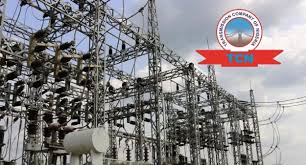Oil & Energy
TCN Targets Power Restoration To North-East, May 27

The Transmission Company of Nigeria (TCN) has said electricity supply will be fully restored to the North-East by May 27.
TCN’s spokesperson, Ndidi Mbah, who disclosed this in a statement made available to newsmen, weekend, said the commission’s contractors were working to erect four new transmission towers along the Jos-Gombe axis, to enable the restoration of power supply to States in the North-East region of the country.
Recall that TCN had on April 23, said four of its towers along the Jos–Gombe 330 kilo volt (kV) transmission line were vandalised, affecting electricity supply to Gombe, Damaturu, Maiduguri, Yola, Bauchi, and Jalingo.
“The tower collapse affected Gombe, Damaturu, Maiduguri, Yola, Bauchi and Jalingo. Immediately after the incident, however, TCN engineers worked first to redistribute available bulk supply on the Jos, Bauchi, Gombe 132kV line between Jos and Yola Discos, while work commenced immediately at reconstructing the four vandalised towers”, the commission said.
It continued that “Presently, we are rebuilding the four towers simultaneously. Progress is evident, with one tower nearing 80% completion, another at 60%, a third at 30%, and dismantling work finished on the fourth tower”.
Additionally, she said, “tower members” are being fabricated and assembled on-site to expedite work, adding that TCN is dedicated to the quick restoration of bulk power on the line route.
“Construction work on the Jos – Gombe transmission line, taking supply up to Damaturu and environs will be completed and energized by the 20th of May, 2024, while the Damaturu – Maiduguri axis will be completed on the 27th of May, 2024.
“Expectedly, bulk power transmission would be fully restored on the affected 330kV transmission line by the 27th of May. Yola and Jos DisCos would also be able to offtake and distribute optimally from TCN substations.
“For now, only 38MW is wheeled to both Jos and Yola Distribution companies, with each receiving 19MW each. Efforts to take some of the available power to Jalingo was hampered by very high voltage on the line, which could cause a system disturbance”.
According to the spokesperson, TCN is aware of the inconveniences caused by the current insufficient power supply through Yola and Jos DisCos to electricity customers in the affected states.
Mbah further said the company pledged to earnestly expedite work on the towers to guarantee that the towers are completed within the specified time frame.
Oil & Energy
Navy Nabs Six Oil Thieves, Dismantles Illegal Refining Site

The Nigerian Navy Units under the auspices of Operation Delta Sanity says it has recorded significant successes against crude oil theft and illegal refining sites in the Niger Delta.
The Navy, in an updated operations, said the successes were recorded between Thursday August 29 and Monday September 2, 2024.
According to the information, on 29th August, seven large cotonou and two fibre boats operated by heavily armed oil thieves loading crude oil from an illegal loading point around Botokiri axis of Nembe Local Government Area of Bayelsa State were seized.
Also, on 31st August, six suspected crude oil thieves with 109 sacks of illegally refined petroleum products, four fibre boats and two wooden boats were arrested and seized along Ogboinbiri-Kasama-Azama-Isoni of Bayelsa State.
Again, on 1st September, two wooden boats and 328 sacks of illegally refined automated Gas Oil were seized at Otuogori community’s river bank in Yenagoa, Bayelsa State.
Additionally, on 2nd September, 35 sacks of illegally refined Automotive Gas Oil in a wooden boat were seized at Gbaraun area of Southern Ijaw Local Government Area of Bayelsa State.
These successes indicate the effectiveness of Operation Delta Sanity, and the resolve of the Nigerian Navy to sustain current efforts to rid Nigeria’s maritime environment of the menace of crude oil theft and enhance crude oil production for the overall growth of the economy.
Oil & Energy
Security Agencies, MDAs Owe Eko DISco N42bn – BPE

The Eko Electricity Distribution Company Plc. has clarified that the Ministries, Departments, and Agencies of the Federal Government, including the military, owed the power distribution company N42billion as the cost of electricity consumed and not N144billion.
The Bureau of Public Enterprise(BPE), disclosed this in a Statement signed by the Head, Public Communications, Amina Othman, at the Weekend.
According to the Statement, the Disco affirmed that its total outstanding debt was N144billion, of which the MDAs and the military owe N42billion.
“The Eko Electricity Distribution Company Plc has clarified that contrary to earlier reports, the aggregate outstanding debt owed by consumers is N144billion, out of which, ministries, departments, and agencies including the military owe N42billion”, Othman stated.
The Statement said this was against prior reports that the MDAs, including the army, police, and other government agencies, were owing N144billion and had refused to pay.
The Disco said, “the clarification became necessary for proper reportage on the matter and to put the records straight”, it stated.
Recall that during a recent oversight visit by members of the House of Representatives Committee on Privatisation and Commercialisation, led by its Chairman, Ibrahim, the Acting Managing Director of the EKEDC, Mrs. Rekhiat Momoh, among other things, informed the members about the legacy debts owed the company by MDAs.
The committee had reported the acting MD as stating that the company was owed N144billion by MDAs within its operational area, saying she mentioned that the military, police, and various state government agencies failed to settle their debts, creating financial difficulties for the distribution company.
Oil & Energy
Unveiling Of Crane: Energy Infrastructure Set To Get Boost

Energy infrastructure, a crucial part of global oil and gas supply and the energy transition, are set to get a boost after a heavy lifting equipment provider unveiled the world’s strongest crane-equipment capable of lifting 6,000 tons, or 15 fully loaded Boeing 747 aircraft.
Dutch heavy lifting and transport services company Mammoet has launched a new type of crane, the SK6,000, which, the firm said, could be used for modules to be built faster and also “bigger than ever before”.
As oil and gas continue to be a key part of the world’s energy system—and likely will continue for decades to come—and as renewable energy developers aim for bigger wind turbines, the support equipment for installing oil and gas platforms, offshore wind equipment, and even nuclear power stations is becoming bigger.
Bigger cranes such Mammoet’s SK6,000 could remove some of the limitations of engineering and construction firms. These firms are generally limited by how much weight can be lifted when installed on a platform or turbine.
Cranes that can carry 5,000 tons and more can shorten the time of a project being erected on a site, onshore or offshore, Mammoet says.
“Limitations on lifting capacity force engineers to fabricate smaller modules than would be optimal; tying up site space and increasing the complexity and duration of projects,” the company notes.
“This limitation can also narrow the execution choices available during each project’s planning stage and the percentage of each project that can be executed locally.”
These days, energy companies and their contractors seek faster deployment of energy infrastructure, be it wind turbines or floating production storage and offloading (FPSO) vessels and platforms for oil and gas production.
“There are so many supply chain constraints at the moment that need to be de-bottlenecked,” Gavin Kerr, Mammoet’s director of global services, told Bloomberg, commenting on the new crane.
“The bigger everything gets, you need bigger cranes.”
Moreover, the SK6,000 is containerised and can be assembled quickly on-site. This feature allows it to deliver heavy lift capability wherever it is needed, giving contractors greater flexibility in where and how energy projects are completed” Mammoet said.
“With the innovation of the SK6,000 crane, our customers can think bigger than ever before; pushing modules beyond the 4,000t and even 5,000t barriers. Its low ground bearing capacity also means the crane can be used all over the world”, said Mammoet’s Sales Director Giovanni Alders.
“With its long outreach, small minimum footprint and relatively small site impact, the SK6,000 greatly reduces the topside integration time.
“Needless to say, with larger building blocks you spend less time connecting and testing, and more time producing” Alders added
Energy companies do need faster permit-to-production times in both oil and gas and renewable energy to provide the conventional and green energy sources the world will need.
Wind turbine technology is evolving and making the hub height increasingly taller. According to the Office of Energy Efficiency & Renewable Energy at the U.S. Department of Energy, the hub height for utility-scale land-based wind turbines has surged by 83per cent since 1998–1999, to about 103.4 meters (339 feet) in 2023. That’s taller than the statue of Liberty.
The average hub height for offshore wind turbines in the United States is projected to grow even taller from 100 meters (330 feet) in 2016 to about 150 meters (500 feet), or about the height of the Washington Monument, in 2035, DOE said.
In the oil and gas industry, new resource development is needed as demand for LNG grows and legacy oilfields mature and output declines.
If contractors can bring energy projects on stream faster, both oil and gas supply and the energy transition will benefit.
By: Charles Kennedy



